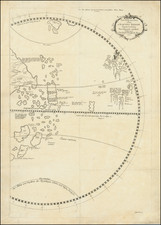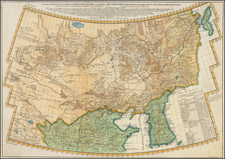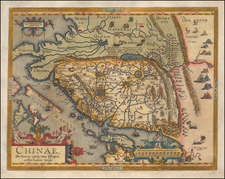The Earliest Known Map of China and A Chinese Map of The Heavens
Enormously rare rubbing of the emblematic Dili Tu [Geographic Map of China] stone map and the Tianwen tu [A Map of the Stars] star chart, originally made in ca. 1190 by the polymath Huang Shang 黃裳. Carbon dating has placed these examples as being made between 1493 and 1602, the earliest-known rubbings from the stones. They are also some of the earliest surviving cartographic materials made in all of China in the Common Era.
The Dili tu shows China in exacting detail for the period and both documents were originally presented to the Song Emperor in 1194. Unfortunately, the original map of China and the star chart do not survive. However, a half century after they were made, in 1247, Wang Zhiyuan 王致遠 engraved the works on stone stelae. This is the earliest-known of the few rubbings taken from the stones. The rubbings are an extreme rarity, particularly outside of Asia, and are seldom seen on the market. A rubbing made this early is an unparalleled cartographic object of the utmost scarcity.
The Dili tu map
The size of the original Dili tu map was roughly 3.75 x 3.25 feet. The present example, a rubbing dating from the nineteenth century, shows the many details of the map. China is laid out on the top two thirds of the rubbing, with hundreds of settlements shown in oval and rectangle cartouches. Mountains, hills, and forests are elegantly added in among the characters, with China’s many rivers flowing throughout.
The Great Wall to the north is marked with a double line. In this map, the Yellow River flows from Jishi Mountain. Other maps feature the Kunlun Mountain as the Yellow River source. Here, Kunlun Mountain is pushed far away to the west, as far as possible from the core imperial territories.
The bottom third of the rubbing is filled with notes describing not only the geography, but also the history of China. It is standard in Chinese mapmaking to pair graphic depiction with expository text. Here, the text at the bottom links time and space, describing the history of China beginning from the founding narrative of Yu the Great who tamed the rivers and land. The thrust of the narrative discusses the perennial fragmentation and reunification of the empire.
Some of the characteristics of the map suggest that it derives from an earlier source map. The cartographic principles involved are in the Huayi tu tradition [Map of China and the Barbarians, 1137]. The mountains and forests are naturalistically drawn in, there is no grid system, and the place-names are inserted in cartouches. The coastline and the Shandong peninsula are, however, better represented than in the 1137 map. One of the many scholars who has studied this map, Aoyama, considers that in all its essentials, the contents and style of the Dili tu date to Shen Kuo’s time, a century earlier than the initial creation date of ca. 1190.
The three characters at the top suggest a transliteration of zhuili. However, the title is more properly "Dili tu 墬理圖". This literally means "diagram of terrestrial organization" or, more simply, "map of geography". This differentiates this map from maps of astronomy or cosmography. The zhui 墜 (to fall) is a variant for di 墬, which is itself an ancient variant for di 地 (earth). Dili 地理, or in this case dili 墬理, means terrestrial organization or simply geography. Some scholars in China thus refer to this map as the 地理圖 (地理图 in simplified characters).
The Tianwen tu star chart
Also known as the Sooochow (Suzhou) Planisphere, this chart depicts a sky that shows constellations from the north celestial pole to 55 degrees south. A central circle represents the north celestial pole (at center) to roughly 35 degrees north. It contains the circumpolar constellations.
The lines radiating from the central circle are the 28 xiu, or mansions, which make up the Chinese constellations system. They are similar to the Western Zodiac system, although they represent the movement of the moon during a sidereal month and not the Sun in a tropical year, as the Zodac does. The 28 mansions are divided into four regions, which are identified with an animal (Azure Dragon, Black Tortoise, White Tiger, and Vermilion Bird). Each mansion line corresponds to the longitude along the ecliptic that the Moon crosses as it orbits the Earth.
Hundreds of constellations are shown with snaking lines and characters. The text below explains that 1565 stars are known to astronomers, but only 1440 are depicted. The two overlapping circles within the planisphere are the celestial equator and the ecliptic. In Chinese astronomy these are called the Red Road and the Yellow Road, respectively. A final detail is the band that curves through the chart; this is the Milky Way, called the River of Heaven.
The text under the chart begins:
Before the Great Absolute had unfolded itself the three primal essences, Heaven, Earth, and Man, were involved within it. This was termed original chaos because the intermingled essences had not yet separated. When the Great Absolute unfolded, the light and pure formed Heaven, the heavy and impure formed Earth, and the mingled pure and impure formed Man. The light and pure constitute spirit, the heavy and impure constitute body, and the union of body and spirit constitute man.
The text was meant as an instructional aid to the young prince who Huang Shang tutored. Together with the Dili tu and the other materials prepared by the tutor, the chart communicates the place of China in the universe and suggests the order necessary for a peaceful and prosperous empire.
Creation, preservation, and subsequent rubbings made in China
The cartographer, geographer, astronomer, and imperial tutor Huang Shang produced between four (Cao 1958) and eight (Needham 1979) maps in 1190 (Cao) or 1193 (Needham), which were presented to Emperor Ningzong of the Song 宋光宗 in 1194. These include an astronomical star chart (Tianwen tu), a diagram of the quasi-mythical imperial lineage (Diwang shaoyun tu), and a map of the Chinese empire (Dili tu). It is unclear whether a city map of present-day Suzhou (Pingjiang tu) was also produced by Huang.
These four documents were carved onto stone stelae in the first half of the thirteenth century, with both the Dili tu and the Tianwen tu carved in 1247 by Wang Zhiyuan. All four of the stone documents of Huang Shang are still extant and preserved, albeit with varying degrees of damage. The Dili tu is at the Museum of Engraved Stone Tablets in the Confucian Temple in Suzhou (Suzhou wenmiao 苏州文庙). The Tianwen tu is at the Purple Mountain Observatory.
These four items constitute the bulk of the earliest extant conventionally-recognized Chinese maps from the Common Era (there are a handful of extant maps from before the Common Era, but relative silence for the first millennium CE). The other two key maps from this period are the aforementioned Huayi tu and the Yuji tu, each carved onto one side of the same stele in 1136. They are preserved today in the Forest of Stone Stelae Museum in Xi'an.
Today, rubbings taken from the stones are highly regulated by the Chinese government, in order to preserve the stones from further damage. Several rubbings were taken in the nineteenth and twentieth centuries, but the present examples antedate these by 200 years and are the earliest known surviving rubbings. They are an important and unprecedented discovery showcasing Chinese cartographic history.
Mapping in China
Mapping has a long history in China, where they were used for administration, illustration, and education. They depicted physical space, but also could be used to show the connection between earth and heaven; maps could be cosmological tools as well as political tools.
Until the end of the Qing dynasty, no specialized group existed for mapmaking. Instead, mapmakers tended to be government officials or scholars, but there was no formal training in cartography per se. This meant that surviving maps are of varying quality and detail, depending on the maker, purpose and intended audience for the work.
Many Chinese maps are concerned not only with geography, but with history. This is true of the Dili Tu. As Yee points out, it shows the capitals of the Northern Song (960-1126) and Liao dynasties, both of which had been lost to the Jin. Elsewhere, a note mentions Guangwudi (r. 25-57), restorer of the Han dynasty (206 BC-220 CE). By referencing recent losses and previous rulers, the map was intended to teach a new ruler the extent of his lands, the possible expansion he could undertake, and the stakes of following in august footsteps like those of Guangwudi.
The earliest extant “world-maps” in China date from the Song dynasty (960-1279), precisely the period when these items were drawn. Another example is the Gujin Huayi quyu zongyao tu [General Map of Chinese and Barbarian Territories, Past and Present], which dates to ca. 1130. More famous is the Huayi tu [Map of China and the Barbarians; 1136], to which the Dili Tu seems to be connected.
The Song Dynasty
These stone maps were made during the Song Dynasty, an influential period in Chinese history. Lasting from 960 to 1279, the Song Dynasty ruled when Marco Polo visited China. The stories he brought back impressed European readers and filled their imaginations for several centuries. Many of the things that so impressed Polo, and which became features which Westerners associated with Chinese culture, were adopted during the Song Dynasty. These include the widespread drinking of tea, the adoption of a rice-based diet, the distinctive curved-up corners of roofs, and, less positively, the binding of women’s feet (now outlawed). China was the most technologically-advanced society in the world at the time, with particular innovations in iron-working, printing, and agriculture.
Founded by Zhao Kuangyin, the Song Dynasty came to power via a coup d’état in 960. Zhao Kuangyin was a military inspector, which gave him the powerful position necessary to take over the government. Zhao, known as Emperor Taizu, consolidated power, strengthened the civil service, and honed the skills of the empire’s elite military units, all of which helped him to expand the empire southward.
His successors maintained the large empire Taizu had created, but the bureaucracy weakened over time. In the twelfth century, the Jin managed to wrestle nearly half of the Song’s territory from them, although the Jin were stopped at the Yangtze River. From 1127, the Southern Song Dynasty continued to rule, led first by the Emperor Gaozong. He again strengthened the civil service.
The map and star chart were made as teaching aids for a young prince who was to become the Emperor Ningzong (r. 1195-1224). During his reign, Ningzong again tried to expand north and reclaim the lands held during the Northern Song, but he was pushed back.
Outside forces continued to interfere. The Mongols, led by Genghis Khan, attacked the Jin to the north in 1211. After decades of uneasy peace, the Mongols, now led by Khan’s grandsons, then attacked the lands of the Southern Song. The capital, Lin’an (Hangzhou), fell in 1276 and the dynasty failed in 1279.
At the time the map stones were made, there were several cities with populations over 1,000,000 in China. The Song Dynasty oversaw a large increase in the population of China, as well as the spread of the use of paper money, the creation and expansion of a welfare state, the adoption of moveable type, and the organization of trade guilds. It was a time of prosperity for China and these documents are but one example of that economic and intellectual success.
Rarity and carbon dating
Although the original maps are no longer extant, the 1247 stone stelae are. They are kept in the Museum of Engraved Stone Tablets at the Suzhou Confucian Temple (Dili tu) and the Purple Mountain Observatory (Tianwen tu).
Rubbings of this quality are very rare, as the Chinese government closely regulates how many can be made. Additionally, most extant rubbings are held in institutions within China, making this one of the few examples outside of Asia. The majority of these were made in the nineteenth and twentieth centuries.
Upon discovery of the present examples, Barry Lawrence Ruderman Antique Maps and Kevin Brown of Geographicus decided to send samples for carbon dating. The canvas backing on these rubbings dates from the nineteenth century, but the original rubbing was thought to be made earlier. A sample from the terrestrial map was chosen as the base example; the two specimens are on identical paper, with our assumption that the results apply to both items.
The results revealed that the maps were not of this nineteenth- to twentieth-century rubbing grouping, but two entire centuries older than that. The carbon dating results said that the rubbings are on paper from a date range of 1493 to 1602. This makes these examples the oldest extant rubbings of the maps.
For the Tianwen tu, the last rubbings were made in the 1990s when the Chinese government authorized ten rubbings to be made; nine went to Chinese museums and institutions, and one is now in the History of Chinese Science and Culture Foundation in London. As their website says, ‘this is believed to be the only original rubbing of it in the West’, which makes the present example only the second known example in the West, in addition to the oldest.
These rubbings are extraordinary items of the greatest historical importance. They antedate the other known rubbings by more than 200 years and are the rarest of the already rare rubbings from these stone maps. They are some of the only known examples in the west and would make a crowning addition to any collection of Chinese maps.
Aoyama Sadao, 青山定雄. Nansō Junyū no Sekkoku Chirizu ni tsuite 南宋淳祐の石刻墜理図について [Concerning the General Map of China carved on stone in the Chunyou reign of the Southern Song], Tōhō gakubō Tōkyō 東方学報東京第十一冊之一, 1940年3月 (March 1940); Peter K. Bol, "Exploring the Propositions in Maps: The Case of the 'Yuji tu' of 1136," Journal of Song-Yuan Studies 46 (2016): 209-224; Cao Wanru 曹婉如, “介绍三幅古地图,” 文物参考资料, 1958 [07]; Cao Wanru 曹婉如, ed. Zhongguo gudai ditu ji 中國古代地圖集. 3 vols. Beijing: Wenwu chubanshe, 1990–1997; Édouard Chavannes, "Les deux plus anciens specimens de la cartographie chinoise," Bulletin de l'École française d'Extrême-Orient 3 (1903): 214–47; Laura Hostetler, Qing Colonial Enterprise: Ethnography and Cartography in Early Modern China (Chicago: University of Chicago Press, 2001); Joseph Needham, Science and Civilisation in China Vol. 3, Mathematics and the science of the heavens and the earth (Cambridge University, 1959), 278-9, 281, 549-551; Ian Ridpath, “Charting the Chinese Sky”, http://www.ianridpath.com/startales/chinese3.htm; W. Carl Rufus and Hsing-Chih Tien, The Soochow Astronomical Chart (Ann Arbor: University of Michigan Press, 1945); Richard J. Smith, Mapping China and Managing the World: Culture, Cartography, and Cosmology in Late Imperial Times (London: Routledge, 2013); W. E. Soothill, "The Two Oldest Maps of China Extant," The Geographical Journal. 69, no. 6 (1927): 532–551; G. Vacca, "Due Astronomi Cinesi del IV Sec. AC e i loro cataloghi stellari," (Zanichelli, Bologna), 1934; Yong Wang, Zhongguo di tu shi gang [Brief history of Chinese cartography] (Beijing: Shang wu yin shu guan, 1959); Yong Wang, Zhongguo dilixue shi [History of geography in China] (1938; reprinted Taipei: Shangwu Yinshuguan, 1974); Cordell D. K. Yee with John B. Henderson, “Part One: Cartography in China,” in The History of Cartography, Cartography in the Traditional East and Southeast Asian Societies, vol. II, edited by J. B. Harley and David Woodward (Chicago: University of Chicago Press, 1994).












![(Silk Route Region / Western China) [Octava Asie Tabula]](https://storage.googleapis.com/raremaps/img/small/84174.jpg)
![[ Beijing ] Peking](https://storage.googleapis.com/raremaps/img/small/101285.jpg)


